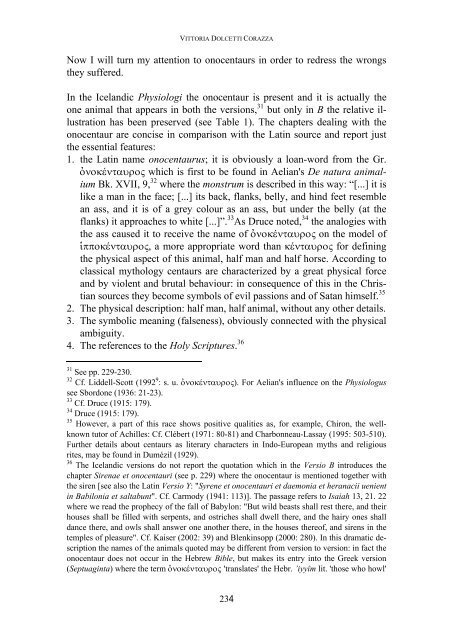Crossing paths in the Middle Ages: the Physiologus in Iceland - Lear
Crossing paths in the Middle Ages: the Physiologus in Iceland - Lear
Crossing paths in the Middle Ages: the Physiologus in Iceland - Lear
Create successful ePaper yourself
Turn your PDF publications into a flip-book with our unique Google optimized e-Paper software.
VITTORIA DOLCETTI CORAZZA<br />
Now I will turn my attention to onocentaurs <strong>in</strong> order to redress <strong>the</strong> wrongs<br />
<strong>the</strong>y suffered.<br />
In <strong>the</strong> <strong>Iceland</strong>ic Physiologi <strong>the</strong> onocentaur is present and it is actually <strong>the</strong><br />
one animal that appears <strong>in</strong> both <strong>the</strong> versions, 31 but only <strong>in</strong> B <strong>the</strong> relative illustration<br />
has been preserved (see Table 1). The chapters deal<strong>in</strong>g with <strong>the</strong><br />
onocentaur are concise <strong>in</strong> comparison with <strong>the</strong> Lat<strong>in</strong> source and report just<br />
<strong>the</strong> essential features:<br />
1. <strong>the</strong> Lat<strong>in</strong> name onocentaurus; it is obviously a loan-word from <strong>the</strong> Gr.<br />
5nokéntauroς which is first to be found <strong>in</strong> Aelian's De natura animalium<br />
Bk. XVII, 9, 32 where <strong>the</strong> monstrum is described <strong>in</strong> this way: “[...] it is<br />
like a man <strong>in</strong> <strong>the</strong> face; [...] its back, flanks, belly, and h<strong>in</strong>d feet resemble<br />
an ass, and it is of a grey colour as an ass, but under <strong>the</strong> belly (at <strong>the</strong><br />
flanks) it approaches to white [...]”. 33 As Druce noted, 34 <strong>the</strong> analogies with<br />
<strong>the</strong> ass caused it to receive <strong>the</strong> name of 5nokéntauroς on <strong>the</strong> model of<br />
$ppokéntauroς, a more appropriate word than kéntauroς for def<strong>in</strong><strong>in</strong>g<br />
<strong>the</strong> physical aspect of this animal, half man and half horse. Accord<strong>in</strong>g to<br />
classical mythology centaurs are characterized by a great physical force<br />
and by violent and brutal behaviour: <strong>in</strong> consequence of this <strong>in</strong> <strong>the</strong> Christian<br />
sources <strong>the</strong>y become symbols of evil passions and of Satan himself. 35<br />
2. The physical description: half man, half animal, without any o<strong>the</strong>r details.<br />
3. The symbolic mean<strong>in</strong>g (falseness), obviously connected with <strong>the</strong> physical<br />
ambiguity.<br />
4. The references to <strong>the</strong> Holy Scriptures. 36<br />
31<br />
See pp. 229-230.<br />
32 9<br />
Cf. Liddell-Scott (1992 : s. u. 5nokéntauroς). For Aelian's <strong>in</strong>fluence on <strong>the</strong> <strong>Physiologus</strong><br />
see Sbordone (1936: 21-23).<br />
33<br />
Cf. Druce (1915: 179).<br />
34<br />
Druce (1915: 179).<br />
35<br />
However, a part of this race shows positive qualities as, for example, Chiron, <strong>the</strong> wellknown<br />
tutor of Achilles: Cf. Clébert (1971: 80-81) and Charbonneau-Lassay (1995: 503-510).<br />
Fur<strong>the</strong>r details about centaurs as literary characters <strong>in</strong> Indo-European myths and religious<br />
rites, may be found <strong>in</strong> Dumézil (1929).<br />
36<br />
The <strong>Iceland</strong>ic versions do not report <strong>the</strong> quotation which <strong>in</strong> <strong>the</strong> Versio B <strong>in</strong>troduces <strong>the</strong><br />
chapter Sirenae et onocentauri (see p. 229) where <strong>the</strong> onocentaur is mentioned toge<strong>the</strong>r with<br />
<strong>the</strong> siren [see also <strong>the</strong> Lat<strong>in</strong> Versio Y: "Syrene et onocentauri et daemonia et heranacii uenient<br />
<strong>in</strong> Babilonia et saltabunt". Cf. Carmody (1941: 113)]. The passage refers to Isaiah 13, 21. 22<br />
where we read <strong>the</strong> prophecy of <strong>the</strong> fall of Babylon: "But wild beasts shall rest <strong>the</strong>re, and <strong>the</strong>ir<br />
houses shall be filled with serpents, and ostriches shall dwell <strong>the</strong>re, and <strong>the</strong> hairy ones shall<br />
dance <strong>the</strong>re, and owls shall answer one ano<strong>the</strong>r <strong>the</strong>re, <strong>in</strong> <strong>the</strong> houses <strong>the</strong>reof, and sirens <strong>in</strong> <strong>the</strong><br />
temples of pleasure". Cf. Kaiser (2002: 39) and Blenk<strong>in</strong>sopp (2000: 280). In this dramatic description<br />
<strong>the</strong> names of <strong>the</strong> animals quoted may be different from version to version: <strong>in</strong> fact <strong>the</strong><br />
onocentaur does not occur <strong>in</strong> <strong>the</strong> Hebrew Bible, but makes its entry <strong>in</strong>to <strong>the</strong> Greek version<br />
(Septuag<strong>in</strong>ta) where <strong>the</strong> term 5nokéntauroς 'translates' <strong>the</strong> Hebr. ’iyyîm lit. 'those who howl'<br />
234

















